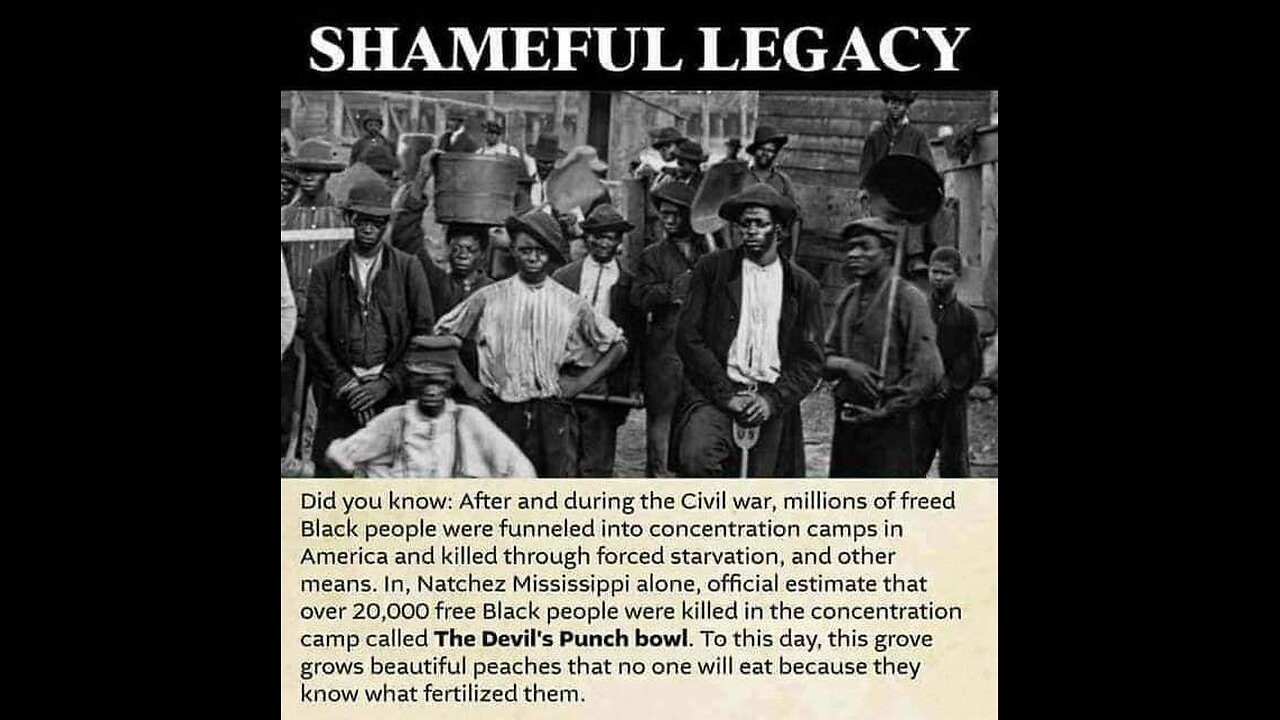Premium Only Content

The Evil of 1863 – A Dark Secret ERASED From American History!"
THIS IS HORRIFIC AMERICAN LEADERS WILL STEAL KILL AND DESTROY TO GET WHAT THEY WANT OUT OF US!!
Our Government has enslaved and taken advantage of the natives in America and even citizens like the Italians, Japanese, Germans.
President Franklin D. Roosevelt issued Executive Order 9066,
under which all people of Japanese ancestry living on the West Coast were rounded up and imprisoned in dozens of civilian assembly centers
(where they were often forced to sleep in crowded, manure-covered horse stables),
relocation centers, military bases, and "citizen isolation centers" -- harsh desert prison camps where "problem inmates," including those who refused to pledge allegiance to the United States, were jailed.
https://www.archives.gov/milestone-documents/list
Reoperations would have to be given to all oppressed peoples in America NOT just one.
They used the blacks to accomplish their take over, promised them freedom them fandangling their way around it.
Author: James E. Yeatman Date:1863
Annotation:
In a letter to President Lincoln, aid workers offer a graphic portrait of the plight of wartime refugees.
https://www.digitalhistory.uh.edu/disp_textbook.cfm?smtID=3&psid=409
The Emancipation Proclamation January 1, 1863
https://www.nps.gov/museum/tmc/Antietam/Lesson3/The%20Emancipation%20Proclamation%20text%20copy.pdf
A Brief History of US Concentration Camps
There is no doubt that concentration camps are in operation on US soil once again
https://www.history.com/topics/black-history/fugitive-slave-acts
In order to house the large numbers of African Americans, the Union Army created a concentration camp for newly freed enslaved Black persons at a location known as the Devil’s Punchbowl, a natural pit surrounded by bluffs. Many of the formerly enslaved there died of starvation, smallpox, and other diseases.[1]
It has been suggested by some that over 20,000 formerly enslaved people died here in one year.[2][3]
However,
the scale of the tragedy has been disputed by multiple historians, with history professor Jim Wiggins arguing the 20,000 estimate is baseless and inflated tenfold,[4] and author and activist Ser Seshsh Ab Heter-Clifford M. Boxley referring to the story as “concocted Confederate propaganda” aiming to cast the Union Army in a negative light.[5]
Union troops under Ulysses S. Grant occupied Natchez in 1863; Grant set up his temporary headquarters in the Natchez mansion Rosalie.
Some Natchez residents remained defiant of the Federal authorities.
In 1864,
William Henry Elder, the Catholic bishop of the Diocese of Natchez,
refused to obey a Federal order to compel his parishioners to pray for the President of the United States. U.S. officials arrested Elder, jailed him briefly, and banished him across the river to Confederate-held Vidalia.
Following the Union victory at the Battle of Vicksburg in July 1863, many refugees, including former slaves, freed by the Emancipation Proclamation, began moving into Natchez and the surrounding countryside.
The Union Army officers claimed to be short on resources and unable to provide for the refugees.
The Army planned to address the situation with a mixture of paid labor for freed slaves on government leased plantations,
the enlistment of able bodied males who were willing to fight in the Union Army and the establishment of refugee camps where former slaves could be provided with education. However,
as the war continued, the plan was never effectively implemented and the leased plantations were poorly managed and frequently raided by Confederate troops who controlled the surrounding territory. Hundreds of people living in Natchez during this period,
including many former slaves and refugees, died of hunger, disease or were killed in the fighting during this period.
Emancipation Proclamation (1863) - National Archives
https://www.archives.gov/milestone-documents/emancipation-proclamation
Fugitive Slave Acts ‑ Definition, 1793 & 1850 | HISTORY
https://www.history.com/topics/black-history/fugitive-slave-acts
According to researcher Paula Westbrook, she researched through Adams County Sheriff’s reports from the time.
“When the slaves were released from the plantations during the occupation they overran Natchez. And the population went from about 10,000 to 120,000 overnight,” Westbrook said.
“So they decided to build an encampment for ’em at Devil’s Punchbowl which they walled off and wouldn’t let ’em out,” Don Estes, former director of the Natchez City Cemetery, said.
Estes said that history research is his life. During his studies, he said he learned that Union troops ordered re-captured Black men to perform hard labor. Women and children were all but left to die in the three “punchbowls”.
“Disease broke out among ’em, smallpox being the main one. And thousands and thousands died. They were begging to get out. ‘Turn me loose and I’ll go home back to the plantation! Anywhere but there,” Estes said.
“The Devil’s Punchbowl is a place located in Natchez, Mississippi where during the Civil War; authorities forced tens of thousands of freed slaves to live in concentration camps. Westbrook adds that
“The Union army did not allow them to remove the bodies from the camp.
They just gave ’em shovels and said bury ’em where they drop.”
https://iforcolor.org/devilspunchbowl/
The Devil’s Punchbowl – A U.S. Concentration Camp for Black Slaves?
Devil's Punch Bowl. Type of Resource still image Genre Stereographs Date Created 1850 - 1930
The Devil's Punchbowl :An American Concentration Camp
https://www.chazzwilliams.org/post/copy-of-the-devil-s-punchbowl-an-american-concentration-camp
In 1716 the French founded Fort Rosalie, to protect the trading post which had been established two years earlier in the Natchez territory.
Permanent French settlements and plantations were subsequently developed a dangerous distance from the fort and too near important native locales.[3]
The French inhabitants of the
"Natchez colony" often came into conflict with the Natchez people over land use and resources.
This was one of several Natchez settlements; others lay to the northeast. The Natchez tended to become increasingly split into pro-French and pro-English factions;
those who were more distant had more relations with English traders, who came to the area from British colonies to the east.
After several smaller wars,
the Natchez (together with the Chickasaw and Yazoo) launched a war to eliminate the French in November 1729. It became known by the Europeans as the "Natchez War" or Natchez Rebellion.
The Indians destroyed the French colony at Natchez and other settlements in the area. On November 29, 1729,
the Natchez Indians killed a total of 229 French colonists: 138 men, 35 women, and 56 children (the largest death toll by an Indian attack in Mississippi's history).
They took most of the women and children as captives.
The French with their Indian allies attacked the Natchez repeatedly over the next two years, resulting in most of the Natchez Indians being killed, enslaved,
or forced to flee as refugees. After surrender of the leader and several hundred Natchez in 1731,
the French took their prisoners to New Orleans,
where they were forcibly sold as slaves and shipped as laborers on the Caribbean plantations of Saint-Domingue, as ordered by the French prime minister Maurepas.[4]
Many of the Natchez who escaped enslavement sought refuge with the Creek and Cherokee peoples,
ultimately being absorbed into their people.[5]
Descendants of the Natchez diaspora have reorganized and survive as the Natchez Nation,
a treaty tribe and confederate of the federally recognized Muscogee (Creek) Nation, with a sovereign traditional government.
Following the Seven Years' War, in 1763 Fort Rosalie and the surrounding town, renamed for the defeated tribe, came under British rule. The British Crown bestowed land grants in this territory to officers who had served with distinction in the war. These officers came mostly from the colonies of New York, New Jersey, and Pennsylvania.
They established plantations and brought their upper class style of living to the area. Before 1774, Lord Dartmouth who was Secretary of State for the Colonies and the previous First Lord of Trade,
contemplated siting a civil government below Natchez at White Cliffs which would be the residence of a Lieutenant Governor reporting to Pensacola.[6]
Montfort Browne visited Natchez in 1769 while he was Lieutenant Governor of West Florida; he received a grant near Natchez.[7][8]
Bernard Romans' map Proposals dated August 5, 1773 from Philadelphia[9] to likely subscribers indicated a purpose was to map the Mississippi River from Natchez to the mouth.[10]
During the 1760s and 1770s, the merchants of Natchez handled the Indian trade for other merchants such as McGillivrary & Struthers of Mobile and others.[11]
On February 16, 1779, British authorities in London received several petitions from West Florida proprietors,
merchants and settlers to grant local courts at Natchez, encourage commerce and make land grant reforms.[12]
The Spanish commander, Juan de la Villebreuvre, on September 7, 1779 conquered Fort Bute,
and later the garrison at Baton Rouge and Natchez's Fort Panmure to establish Spanish colonial rule, but a Natchez loyalist militia forced him to surrender Fort Panmure in May 1781.[13]
A few days later Pensacola was lost by the British and the Natchez revolt collapsed. After defeat in the American Revolutionary War, Great Britain ceded the territory to the United States under the terms of the Treaty of Paris (1783).
Spain was not a party to the treaty, and it was their forces who had taken Natchez from British troops. Although Spain had been allied with the American colonists,
they were more interested in advancing their power at the expense of Britain. Once the war was over,
they were not inclined to give up that which they had acquired by force.
In 1797 Major Andrew Ellicott of the United States of America marched to the highest ridge in the young town of Natchez, set up camp, and raised the first American Flag claiming Natchez and all former Spanish lands east of the Mississippi above the 31st parallel for the United States.
A census of the Natchez District taken in 1784 counted 1,619 people, including 498 black slaves.
The terrain around Natchez on the Mississippi side of the river is hilly. The city sits on a high bluff above the Mississippi River; to reach the riverbank, one must travel down a steep road to the landing called Silver Street, which is in marked contrast to the flat "delta" lowland found across the river surrounding the city of Vidalia, Louisiana. Its early planter elite built numerous antebellum mansions and estates. Many owned plantations in Louisiana but chose to locate their homes on the higher ground in Mississippi. Prior to the Civil War, Natchez had more millionaires than any other city in the United States.[23] It was frequented by notables such as Aaron Burr, Henry Clay, Andrew Jackson, Zachary Taylor, Ulysses S. Grant, Jefferson Davis, Winfield Scott, and John James Audubon.
Today the city boasts that it has more antebellum homes than any other city in the U.S., as during the Civil War Natchez was spared the destruction of many other Southern cities.
The Forks of the Road Market had the highest volume of slave sales in Natchez, and Natchez had the most active slave trading market in Mississippi. This also stimulated the city's wealth. The market, at the intersection of Liberty Street and what was then Washington Street, became especially important after the slave traders Isaac Franklin of Tennessee and John Armfield of Virginia purchased the land in 1823. Tens of thousands of slaves passed through the market, transported from Virginia and the Upper South (many by walking overland), and destined for the plantations in the Deep South. In this forced migration, more than one million enslaved Black American were taken from their families and moved southward.
All trading at the market ceased by the summer of 1863, when Union troops occupied Natchez.[24]
Natchez also has a very unique history as being a region with a substantial number of free persons of color during the era of slavery.[26] Census records from 1850 and 1860 show that about 85% of the free people of color in the antebellum era were mulattoes; the offspring of white male planter fathers and enslaved or emancipates black females to whom the former freed.[27] Mixed raced free people of color in Natchez acquired wealth in several ways. Very often their planter white male fathers gave them inheritances or their half family members set them up in business.[28] Some of the leading free people of color within the Natchez community include such figures as William Johnson, Robert W. Fitzhugh, William McCary and Louis Winston.[29] Robert H. Wood, was another prominent free person of color. He became the mayor of Natchez which was the exact same position his white planter father Robert Wood occupied years earlier.[30] It was initially believed in post modern times that free people of color lacked a lot of citizen rights regardless of their status.[31] Research in recent decades through courthouse and governmental records has substantially demonstrated that to be untrue for the wealthy property owning free people of color.[32] Owning wealth and being included as equals by the richest of the white families in the antebellum era gave the few people of color who had this circumstance a rare amount of prestige and power. William Johnson, a well known free person of color strives to be recognized as a planter by Natchez society;[33] Archie P. Williams a free person of color who was also of Natchez was recognized in society as a planter[34][35][36] due to being the son of David Percy Williams[37] of Natchez and inheriting a large portion of his wealth. Archie P. Williams white side of his family lineage had been established as one of the wealthiest in the region for several generations prior beginning in the 1760s with his great grandfather David Williams. Archie P. Williams was one of a few millionaires
(especially mixed -race or black millionaires) in the 1800s due to his inherited share
of the multi million dollar estate of Winthrop Sargent who was a stepfather to his grandfather.[3
https://en.wikipedia.org/wiki/History_of_Natchez,_Mississippi
ORIGINAL LINK FOUND ON Black Journals
-
 21:07
21:07
Watchman's Duty
4 days agoChina’s CITY WIDE CASH SEIZURES Begin — ATMs Frozen, Digital Yuan FORCED Overnight
1.31K1 -
 41:26
41:26
The Mel K Show
3 hours agoMel K & Clay Clark | Financial Success Hides Behind Self Discipline: Five Pillars | 8-24-25
9.39K -
 LIVE
LIVE
Lofi Girl
2 years agoSynthwave Radio 🌌 - beats to chill/game to
487 watching -
 LIVE
LIVE
The Official Steve Harvey
12 days ago $5.01 earned24 HOURS OF MOTIVATION w/ STEVE HARVEY
507 watching -
 25:56
25:56
DeVory Darkins
20 hours ago $0.50 earnedTrump drops ULTIMATE BOMB on Democrat Mayors as ICE makes SHOCKING Announcement
32.6K156 -
 3:36:30
3:36:30
TonYGaMinG
5 hours ago🟢 ABI WITH FRIENDS | 🍩JOE DONUTS | 😶 🌫 VLADSGAMINGCARTEL |
16.7K4 -
 21:24
21:24
marcushouse
11 hours ago $0.08 earnedStarship Flight 10: Go or No? 🚀
21.8K12 -
 LIVE
LIVE
MrR4ger
16 hours agoSUNDAY FUNDAY w/ R4GER - VARIETY / DIABLO 4/ FOR HONOR / ETC?
93 watching -
 5:40
5:40
WhaddoYouMeme
3 days ago $0.22 earnedThey’re Calling This the End of Masculinity
26.8K28 -
 15:24
15:24
Tactical Advisor
20 hours agoBest 2011 of 2025 | Bul Armory Ultralight Pro
28.2K2